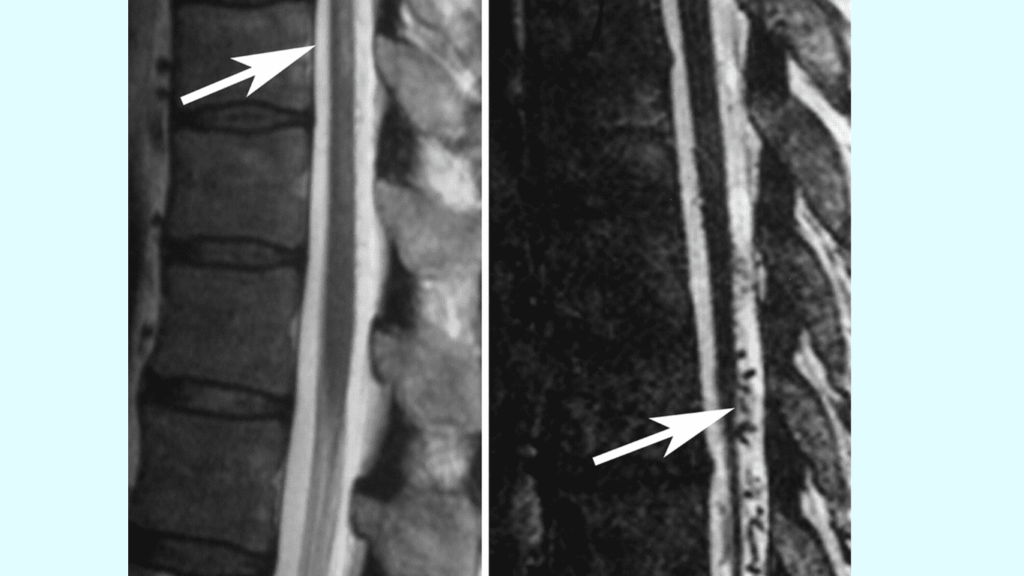
Spinal Dural Arteriovenous Fistula (SDAVF) is a rare vascular condition that affects the spinal cord. While not widely known, it can cause serious neurological symptoms and complications if left untreated. In this article, we will explore the key aspects of SDAVF, including its symptoms, diagnosis, and treatment options.
Body:
- What is Spinal Dural Arteriovenous Fistula (SDAVF)?
Spinal Dural Arteriovenous Fistula is an abnormal connection between arteries and veins within the protective covering of the spinal cord. This condition disrupts normal blood flow, leading to a variety of symptoms. - Symptoms of SDAVF:
- Progressive weakness in the legs
- Numbness or tingling in the lower extremities
- Difficulty walking
- Loss of bladder or bowel control
- Back pain
Spinal dural arteriovenous fistula Causes
While the exact origins of most dural arteriovenous fistulas (dAVFs) remain unknown, some cases are linked to factors such as traumatic head injuries, infections, past brain surgeries, blood clots in deep veins, or tumors.
Many experts believe that dAVFs affecting larger brain veins are caused by the narrowing or obstruction of one of the brain’s venous sinuses. These venous sinuses are channels that facilitate the return of blood from the brain to the heart.
- Diagnosis:
Diagnosing SDAVF can be challenging due to its rarity and varied symptoms. However, healthcare professionals may use a combination of imaging studies, such as magnetic resonance imaging (MRI) and angiography, to identify the abnormal blood flow in the spinal cord. They typically impact older men and are commonly located in the thoracolumbar region. The arteriovenous (AV) shunt is situated within the dura mater near the spinal nerve root, where arterial blood from a radiculomeningeal artery enters a reticular vein. - Risk Factors:
While the exact cause of SDAVF is often unknown, certain risk factors may contribute to its development. These include age, male gender, and other vascular conditions. - Importance of Early Detection:
Early detection of SDAVF is crucial for preventing irreversible damage to the spinal cord. Timely intervention can significantly improve outcomes and quality of life for individuals affected by this condition. - Treatment Options:
- Endovascular Embolization: A minimally invasive procedure where a catheter is used to block the abnormal blood vessels.
- Surgery: In some cases, surgical intervention may be necessary to remove or repair the abnormal connections.
- Radiation Therapy: This may be considered as an alternative or complementary treatment method.
- Recovery and Rehabilitation:
Following treatment, individuals with SDAVF may require rehabilitation to regain strength and functionality. Physical therapy, occupational therapy, and other supportive measures can play a crucial role in the recovery process. - Prognosis:
The prognosis for individuals with SDAVF depends on factors such as the severity of symptoms, the timing of intervention, and the chosen treatment method. Early diagnosis and appropriate treatment generally lead to better outcomes.
Conclusion:
Spinal Dural Arteriovenous Fistula may be a rare condition, but awareness of its symptoms and risk factors is essential for timely diagnosis and treatment. If you or someone you know is experiencing unexplained neurological symptoms, it is crucial to seek medical attention promptly. By understanding SDAVF and its implications, we can contribute to better outcomes and improved quality of life for those affected by this condition.
FAQ
What is a spinal dural arteriovenous fistula?
Spinal Dural Arteriovenous Fistula is an abnormal connection between arteries and veins in side the protective covering of the spinal cord.
What is a spinal extradural AV fistula?
Spinal dural arteriovenous (AV) fistulas represent a frequently encountered vascular anomaly affecting the spinal cord, presenting a manageable etiology for progressive para- or tetraplegia. Predominantly observed in elderly males, these fistulas typically manifest in the thoracolumbar region.



